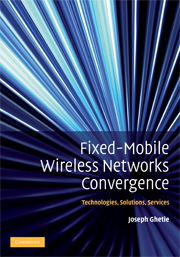Book contents
- Frontmatter
- Contents
- Disclaimer
- How the Book is Organized
- List of Figures
- List of Tables
- Preface
- Acknowledgments
- Acronyms
- Part I Wireless Communications: Networking and Management
- Part II Cellular Mobile Radio Networking and Management
- Part III Fixed Wireless Technologies: Networking and Management
- Part IV Fixed Wireless Cellular Mobile Networks Convergence and Integration
- 10 Fixed-Mobile Convergence Overview
- 11 Wireless LAN Cellular Mobile Convergence
- 12 Wireless PAN Cellular Mobile Convergence
- 13 Wireless MAN Cellular Mobile Convergence
- 14 Wireless Sensor Networks Cellular Mobile Convergence
- Part V Fixed Wireless Cellular Mobile Networks Convergence: Standardized Networking Solutions
- Part VI Fixed-Mobile Convergence Services, Industry Trends, and Implementation Issues
- References
- Index
13 - Wireless MAN Cellular Mobile Convergence
from Part IV - Fixed Wireless Cellular Mobile Networks Convergence and Integration
Published online by Cambridge University Press: 21 August 2009
- Frontmatter
- Contents
- Disclaimer
- How the Book is Organized
- List of Figures
- List of Tables
- Preface
- Acknowledgments
- Acronyms
- Part I Wireless Communications: Networking and Management
- Part II Cellular Mobile Radio Networking and Management
- Part III Fixed Wireless Technologies: Networking and Management
- Part IV Fixed Wireless Cellular Mobile Networks Convergence and Integration
- 10 Fixed-Mobile Convergence Overview
- 11 Wireless LAN Cellular Mobile Convergence
- 12 Wireless PAN Cellular Mobile Convergence
- 13 Wireless MAN Cellular Mobile Convergence
- 14 Wireless Sensor Networks Cellular Mobile Convergence
- Part V Fixed Wireless Cellular Mobile Networks Convergence: Standardized Networking Solutions
- Part VI Fixed-Mobile Convergence Services, Industry Trends, and Implementation Issues
- References
- Index
Summary
WiMAX Mobile Convergent Applications
In Chapter 8 we listed the applications carried over WiMAX networks but didn't separate out those that are facilitated by convergence of WiMAX with other fixed or mobile wired and wireless networks. A short list of WiMAX convergent applications follows. Some of these applications will be detailed when we analyze WiMAX convergent case studies in subsequent sections of this chapter.
WiMAX and cellular mobile convergence (extension of reach and connectivity of cellular mobile networks to remote, rural areas);
WiMAX and WLAN networks convergence;
WiMAX and WLAN metro mesh networks convergence;
WiMAX, WLAN, and WPAN networks convergence;
Backhaul connectivity for cellular mobile networks and traffic;
Backhaul channel for wired Internet Service Providers;
Disaster recovery using WiMAX links as wireless channel alternatives;
WiMAX and EPON (as a backhaul link) networks convergence;
WiMAX-based broadband location/navigation and customer search; and
Internet Protocol Television (IPTV) and High Definition Television (HDTV).
WiMAX and Internet Protocol Television
IPTV, one of the applications listed above, is considered the killer application in both the fixed wired public Internet and cellular mobile networks. WiMAX, as a broadband wireless access network in metropolitan areas, is a good candidate to support IPTV. This support will include video on demand, live content, and multicast video communications, either as managed (paid TV) or unmanaged service (You Tube, for example).
WiMAX technology is strengthened by the degree of mobility conferred by the newly adopted IEEE 802.16e standard.
- Type
- Chapter
- Information
- Fixed-Mobile Wireless Networks ConvergenceTechnologies, Solutions, Services, pp. 256 - 269Publisher: Cambridge University PressPrint publication year: 2008

